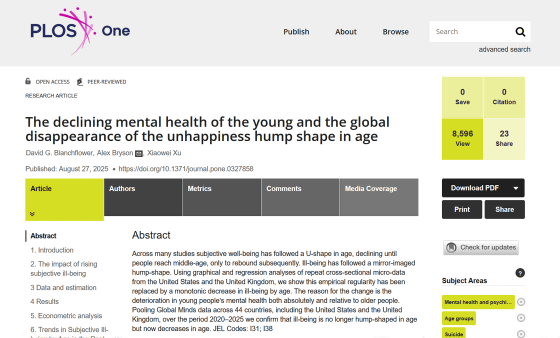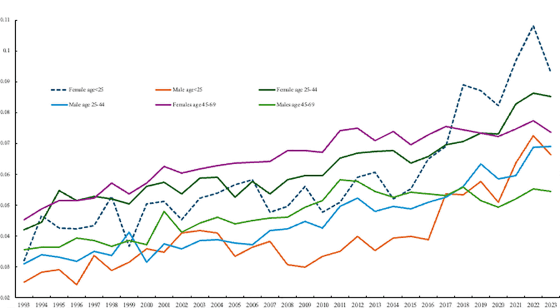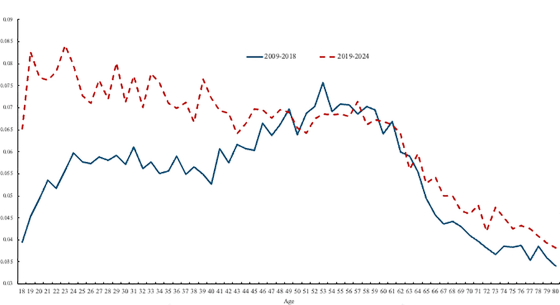Rising unhappiness among young people is changing patterns of happiness over the human lifespan

Longstanding global research has shown that happiness follows a 'U-shaped' pattern, peaking in early life, declining in middle age, and then increasing again in old age. However, a new study based on data from 44 countries shows that this trend is changing in recent years, with unhappiness on the rise among young people.
The declining mental health of the young and the global disappearance of the unhappiness hump shape in age | PLOS One

Lifetime trends in happiness change as misery peaks among the young – new research
https://theconversation.com/lifetime-trends-in-happiness-change-as-misery-peaks-among-the-young-new-research-263665
It has long been known that middle age is the time when people are least happy and most likely to feel miserable, and that happiness over the lifespan follows a U-shaped curve. However, in recent years, there have been signs that happiness is declining even among younger generations, with the deterioration of mental health among young people becoming a problem.
What is the 'U-curve of happiness' that causes misery to peak in middle age? - GIGAZINE

To address this issue, a research team led by Alex Bryson, a professor of quantitative social science at University College London in the UK, conducted a study that collected and analyzed data from 44 countries, including the US and the UK, to investigate how happiness levels across different age groups change over time.
They found that the long-known U-shaped pattern of happiness has been changing in recent years due to 'increasing unhappiness among young people.' In recent years, unhappiness peaks in young people, then declines with age, resulting in a relative increase in happiness. Bryson and his colleagues argue that this change is not due to increased happiness among middle-aged and older people, but rather to the worsening mental health of young people.
The graph below shows the percentage of people experiencing 'hopelessness' by age group and gender from 1993 to 2024, based on publicly available medical data from over 400,000 Americans per year. 'Hopelessness' is defined as those who reported poor mental health at least once during the 30 days prior to the survey. For most of the survey period, hopelessness was highest among those aged 45-69. However, since around 2015, hopelessness has risen sharply among younger people under the age of 25. The hopelessness rate for men under 25 (orange line) increased from 2.5% in 1993 to 6.6% in 2024. The hopelessness rate for women under 25 (blue dashed line) nearly tripled from 3.2% in 1993 to 9.3% in 2024.

Despair also increased significantly among middle-aged people (ages 25-44), but at a slower rate: from 4.2% to 8.4% for women and from 3.1% to 6.9% for men. For those aged 45-69, the increase in despair between 1993 and 2024 was smaller.
As a result, since 2020, the trend in despair levels by age group for women has changed to 'the younger the woman, the higher the level, and the older the woman, the lower the level.' For men, the despair levels are roughly the same for young and middle-aged men, with the elderly showing the lowest levels of despair.
The graph below compares the level of despair by age in the United States from 2009 to 2018 (blue line) and from 2019 to 2024 (red dashed line). From 2009 to 2018, the graph showed a gentle inverted U-shape, but from 2019 to 2024, the trend was that 'the younger you are, the higher your despair.' Similar results were confirmed when analyzing data from the UK.

The reasons for these changes are under investigation, but no clear conclusions have been reached at the time of writing. While increases in feelings of hopelessness were observed even before the COVID-19 pandemic of 2020, the pandemic may have further accelerated the deterioration.
In recent years, studies have shown a link between the internet and smartphones and the deterioration of mental health among young people. However, even if technology is certainly contributing to increased feelings of despair, Bryson and his colleagues believe it is unlikely to be the sole cause.
Social media negatively impacts teen mental health, but the impact differs between boys and girls - GIGAZINE

Bryson et al.'s 2025 findings suggest that while paid workers once tended to have better mental health, in recent years paid work has become less effective at preventing poor mental health. 'The causes of the changes we describe are not yet fully understood,' Bryson et al. wrote. 'However, it would be wise for policymakers to place the issue of rising youth hopelessness at the heart of any well-being strategies.'
Related Posts:
in Science, Posted by log1h_ik







